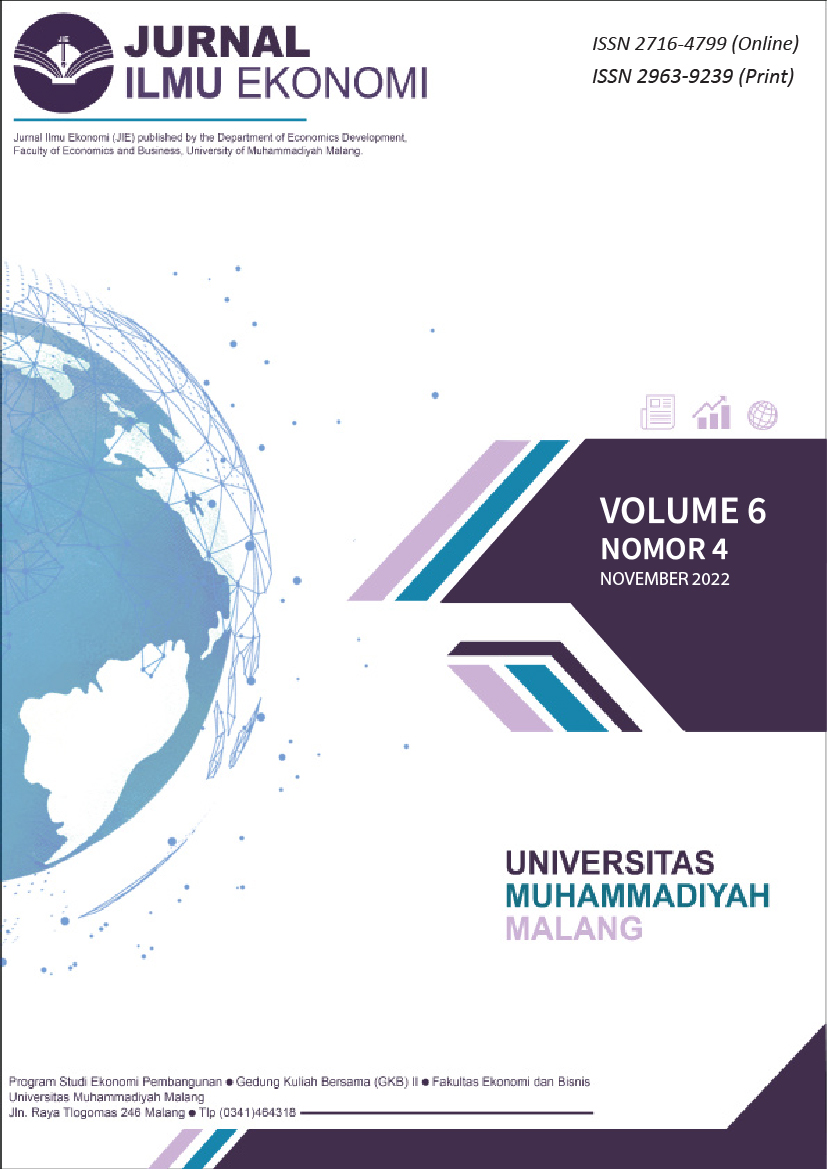Analisis Faktor-faktor yang Mempengaruhi Nilai Ekspor Batubara Indonesia Tahun 2014-2020
DOI:
https://doi.org/10.22219/jie.v6i4.22608Keywords:
Export, Coal, International Trade, Gravity ModelAbstract
This study aims to analyze the impacts of Indonesia's GDP, Export Destination Country GDP, Destination Country Population, Distance, Exchange Rate and Inflation on Indonesia's coal exports in 2014-2020. The data used is secondary data obtained from BPS, World Bank, Bank of International Settlements and Geobytes. The analysis method uses panel data regression with random effect. The results of this study show that Indonesia's GDP, Population of Destination Countries, Exchange Rate and Inflation have a positive and significant influence on Indonesia's coal exports, while the GDP of Export Destination Countries and Distance does not have a significant influence on Indonesia's coal exports.
Penelitian ini bertujuan untuk menganalisis dampak PDB Indonesia, PDB Negara Tujuan Ekspor, Populasi Negara Tujuan Ekspor, Jarak, Nilai Tukar dan Inflasi terhadap ekspor batubara Indonesia pada tahun 2014-2020. Data yang digunakan adalah data sekunder yang diperoleh dari BPS, World Bank, Bank of International Settlements dan Geobytes. Metode analisis menggunakan regresi data panel dengan random effect. Hasil penelitian ini menunjukkan bahwa PDB Indonesia, Populasi Negara Tujuan, Nilai Tukar dan Inflasi memiliki pengaruh yang signifikan terhadap ekspor batubara Indonesia, sedangkan PDB Negara Tujuan Ekspor dan Jarak tidak memiliki pengaruh yang signifikan terhadap ekspor batubara Indonesia.
Downloads
References
Adi, A. C., & Lasnawatin, F. (2021). Handbook of Energy & Economic Statistics of Indonesia. Ministry of Energy and Mineral Resources Republic of Indonesia. https://www.esdm.go.id/en/publication/handbook-of-energy-economic-statistics-of-indonesia-heesi
Ambarita, Y. M. R., & Sirait, T. (2020). Penerapan Model Gravitasi Data Panel: Kajian Perdagangan Internasional Indonesia Ke Negara Anggota Asean. Seminar Nasional Official Statistics, 2019(1), 726–737. https://doi.org/10.34123/semnasoffstat.v2019i1.85
Amir, M. S. (1991). Ekspor Impor Teori dan Penerapannya (Seri Umum No. 3) (p. 4). PT. Pustaka Binaman Pressindo.
Arfiani, I. S. (2019). Analisis Empiris Hubungan antara Ekspor, Impor, Nilai Tukar dan Pertumbuhan Ekonomi di Indonesia. Jurnal Ekonomi Pembangunan, 17(2), 81–98. https://doi.org/10.29259/jep.v17i2.9485
Badan Pusat Statistik. (2022). Kependudukan. https://www.bps.go.id/subject/12/kependudukan.html
Bank Indonesia. (2022). Inflasi. https://www.bi.go.id/id/fungsi-utama/moneter/inflasi/default.aspx
Dashboard Macroeconomics. (2022). Nilai Tukar. https://macroeconomicdashboard.feb.ugm.ac.id/nilai-tukar/
Dinh, T. T. B., Nguyen, V. D., & Hoang, M. C. (2013). Applying Gravity Model To Analyze. 1–24.
Kementrian Energi dan Sumber Daya Mineral. (2022). Cadangan Batubara. https://www.esdm.go.id/id/media-center/arsip-berita/cadangan-batubara-masih-3884-miliar-ton-teknologi-bersih-pengelolaannya-terus-didorong
Khoirudin, R., & Bintoro, D. (2021). Analisis Perdagangan Komoditas Kopi Antara Indonesia Dan 14 Negara Mitra Dengan Pendekatan Model Gravitasi. Perwira Journal of Economics & Business, 1(2), 18–27. https://doi.org/10.54199/pjeb.v1i2.31
Nurrani, G. T. (2020). Analisis Faktor-Faktor yang Memengaruhi Impor Apel di Indonesia. Universitas Islam Negeri Syarif Hidayatullah.
Rochmadianti, R. A. (2017). Model Gravitasi Atas Kinerja Ekspor Indonesia Dengan Lima Mitra Dagang Utama Tahun 2002-2014. Jurnal Ilmiah, 5(2), 1–9.
Salvatore, D. (1997). Ekonomi Internasional (5th ed., p. 6). Salemba Empat.
Saptanto, S., & Soetjitpto, W. (2017). Analisis Model Ekspor Komoditas Perikanan Indonesia Dengan Pendekatan Gravity Model. Jurnal Sosial Ekonomi Kelautan Dan Perikanan, 5(2), 169. https://doi.org/10.15578/jsekp.v5i2.5799
Sitorus, M. (2009). Peningkatan Ekspor CPO dan Kakao di Bawah Pengaruh Liberalisasi Perdagangan (Suatu Pendekatan Model Gravitasi). Institut Pertanian Bogor.
Soelistyo, A. (2012). Model Statis Dan Dinamis Dampak Inflasi. Ekonomika-Bisnis, 03(2), 131–150.
Soraya, B. (2013). Analisis Determinan Ekspor Karet Indonesia dengan Pendekatan Gravity Model. Universitas Sumatera Utara.
Sukirno, S. (2015). Makroekonomi Teori Pengantar (3rd ed.). PT RajaGrafindo Persada.
Utami, A. T. (2019). Pengaruh Produksi, Harga Udang Ekspor, GDP Negara Tujuan Dan Jumlah Penduduk Negara Tujuan Terhadap Ekspor Udang Indonesia Periode 2006-2017 [Universitas Islam Negeri Syarif Hidayatullah]. http://repository.uinjkt.ac.id/dspace/handle/123456789/47502%0Ahttp://repository.uinjkt.ac.id/dspace/bitstream/123456789/47502/1/ANINDYA TRI UTAMI-FEB.pdf
Downloads
Published
How to Cite
Issue
Section
License
Copyright (c) 2022 Azizah, I. A. & Soelistyo, A.

This work is licensed under a Creative Commons Attribution-NonCommercial-ShareAlike 4.0 International License.
Authors who publish with this journal agree to the following terms:
- For all articles published in the JIE (Jurnal Ilmu Ekonomi), copyright is retained by the authors. Authors give permission to the publisher to announce the work with conditions. When the manuscript is accepted for publication, the authors agree to the automatic transfer of non-exclusive publishing rights to the publisher.
- Authors retain copyright and grant the journal right of first publication with the work simultaneously licensed under a Creative Commons Attribution-NonCommercial-ShareAlike 4.0 International License that allows others to share the work with an acknowledgement of the work's authorship and initial publication in this journal.
- Authors are able to enter into separate, additional contractual arrangements for the non-exclusive distribution of the journal's published version of the work (e.g., post it to an institutional repository or publish it in a book), with an acknowledgement of its initial publication in this journal.
- Authors are permitted and encouraged to post their work online (e.g., in institutional repositories or on their website) prior to and during the submission process, as it can lead to productive exchanges, as well as earlier and greater citation of published work (See The Effect of Open Access).
This is an open access article and licensed under a Creative Commons Attribution-NonCommercial-ShareAlike 4.0 International License








